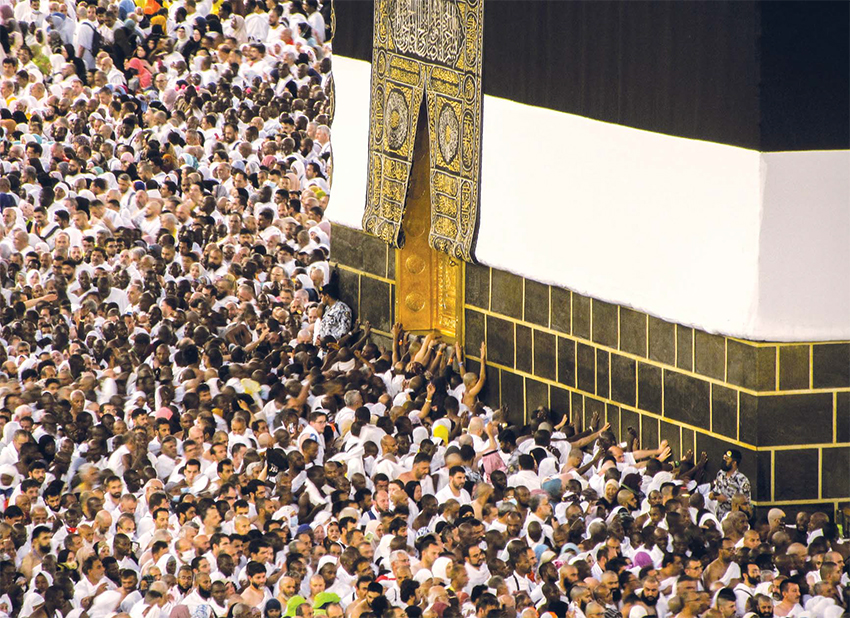25/06/2023
25/06/2023

MAKKAH, Saudi Arabia, June 25, (AP): Pilgrims streamed into Makkah’s Grand Mosque on Saturday to perform their final rituals before heading to Mina in preparation for the Hajj, the fifth pillar of Islam and one of the largest religious gatherings in the world. They moved through the white marble courtyards of Islam’s holiest site to perform the tawaf, the walking circuit around the Ka’aba, the cube-shaped structure covered in a black, goldembroidered cloth, their fervent recitations ringing through the air. People on the ground floor closest to the Ka’aba shuffled due to the sheer number of participants. Those on the upper floors were able to walk more briskly, even run.
Pilgrims raised their hands in supplication, took selfies or video, and phoned their relatives as they performed the tawaf. They then walked or ran between two hills in a re-enactment of Hagar’s search for water for her son, Ismail, a story that occurs in different forms in Muslim, Christian and Jewish traditions. Pilgrims must enter a state of spiritual purity, known as ihram, for the Hajj.
Men wear seamless white robes, a rule intended to promote unity among rich and poor. Women cover their body and hair. In between rituals and the five daily prayers, which bring the area to a solemn standstill, pilgrims sought out shade, snacked and flocked to the many shops and air-conditioned malls encircling the Grand Mosque to relax before the arduous days ahead.
Saudi Arabia has restored full pilgrim capacity for this year’s Hajj, following three years of dramatically reduced numbers due to the pandemic, with more than 2 million Muslims expected to take part. “I think this year (the) crowd is too much” said Mahboub Morshed, a 42-year-old software engineer from Bangladesh, referring to the thinner attendance of previous years. “But the government and this management (Ministry of Hajj and Umrah) is trying to manage this very smoothly.” Over 2 million Muslims will take part in this week’s Hajj pilgrimage to the holy city of Makkah in Saudi Arabia, as one of the world’s largest religious gatherings returns to full capacity following years of coronavirus restrictions.
The Hajj is one of the five pillars of Islam, and all Muslims are required to undertake it at least once in their lives if they are physically and financially able to do so. For the pilgrims, it is a profound spiritual experience that wipes away sins, brings them closer to God and highlights Muslim unity. For the Saudi royal family, which captured Makkah in the 1920s, organizing the pilgrimage is a major source of pride and legitimacy. Authorities have invested billions of dollars in modern infrastructure, but the Hajj has occasionally been marred by tragedy, as in 2015, when over 2,400 pilgrims died in a stampede.
Here’s a look at the pilgrimage, which begins on Monday, and its meaning. The pilgrimage draws Muslims from around the world to Makkah, in Saudi Arabia, where they walk in the footsteps of the Prophet Muhammad (PBUH) and retrace the journey of Ibrahim and Ismail, or Abraham and Ishmael as they are known in the Christian and Jewish traditions. As related in the Holy Quran, Ibrahim is called upon to sacrifice his son Ismail as a test of faith, but God stays his hand at
the last moment. Ibrahim and Ismail later are said to have built the Ka’aba together. In the Christian and Jewish traditions, Abraham nearly sacrifices his other son, Isaac, on Mount Moriah, which is associated with a major holy site in Jerusalem. The Kaaba was a center for polytheistic worship among pagan Arabs until the arrival of Islam in the 7th century, when the Prophet Muhammad (PBUH) consecrated the site and inaugurated the Hajj. Muslims do not worship the Ka’aba, a cube-shaped structure covered in a black, gold-embroidered cloth, but view it as their most sacred place and a powerful symbol of unity and monotheism. No matter where they are in the world, Muslims face toward the Ka’aba during their daily prayers.
The Hajj has been held every year since the time of the Prophet (PBUH), even through wars, plagues and other turmoil. In the Middle Ages, Muslim rulers organized massive caravans with armed escorts that would depart from Cairo, Damascus and other cities. It was an arduous journey through deserts where Bedouin tribes carried out raids and demanded tribute. A notorious Bedouin raid in 1757 wiped out an entire Hajj caravan, killing thousands of pilgrims.
In 2020, amid worldwide coronavirus lockdowns, Saudi Arabia limited the pilgrimage to a few thousand citizens and local residents. This is the first year it returns to full capacity. Some pilgrims spend their whole lives saving up for the journey or wait years before getting a permit, which Saudi authorities distribute to countries based on a quota system. Travel agents offer packages catering to all income levels, and charities assist needy pilgrims. Pilgrims begin by entering a state of spiritual purity known as “ihram.” Women forgo make-up and perfume and cover their hair, while men change into seamless terrycloth robes.
The garments cannot contain any stitching, a rule intended to promote unity among rich and poor. Pilgrims are forbidden from cutting their hair, trimming their nails or engaging in sexual intercourse while in the state of ihram. They are not supposed to argue or fight, but the heat, crowds and difficulty of the journey inevitably test people’s patience. Many Muslims visit Madinah, where the Prophet Muhammad (PBUH) is buried and where he built the first mosque, before heading to Makkah. The Hajj begins with Muslims circling the Ka’aba in Makkah counter-clockwise seven times while reciting prayers. Then they walk between two hills in a reenactment of Hagar’s search for water for her son, Ismail, a story that occurs in different forms in Muslim, Christian and Jewish traditions. All of this takes place inside Makkah’s Grand Mosque - the world’s largest - which encompasses the Ka’aba and the two hills


